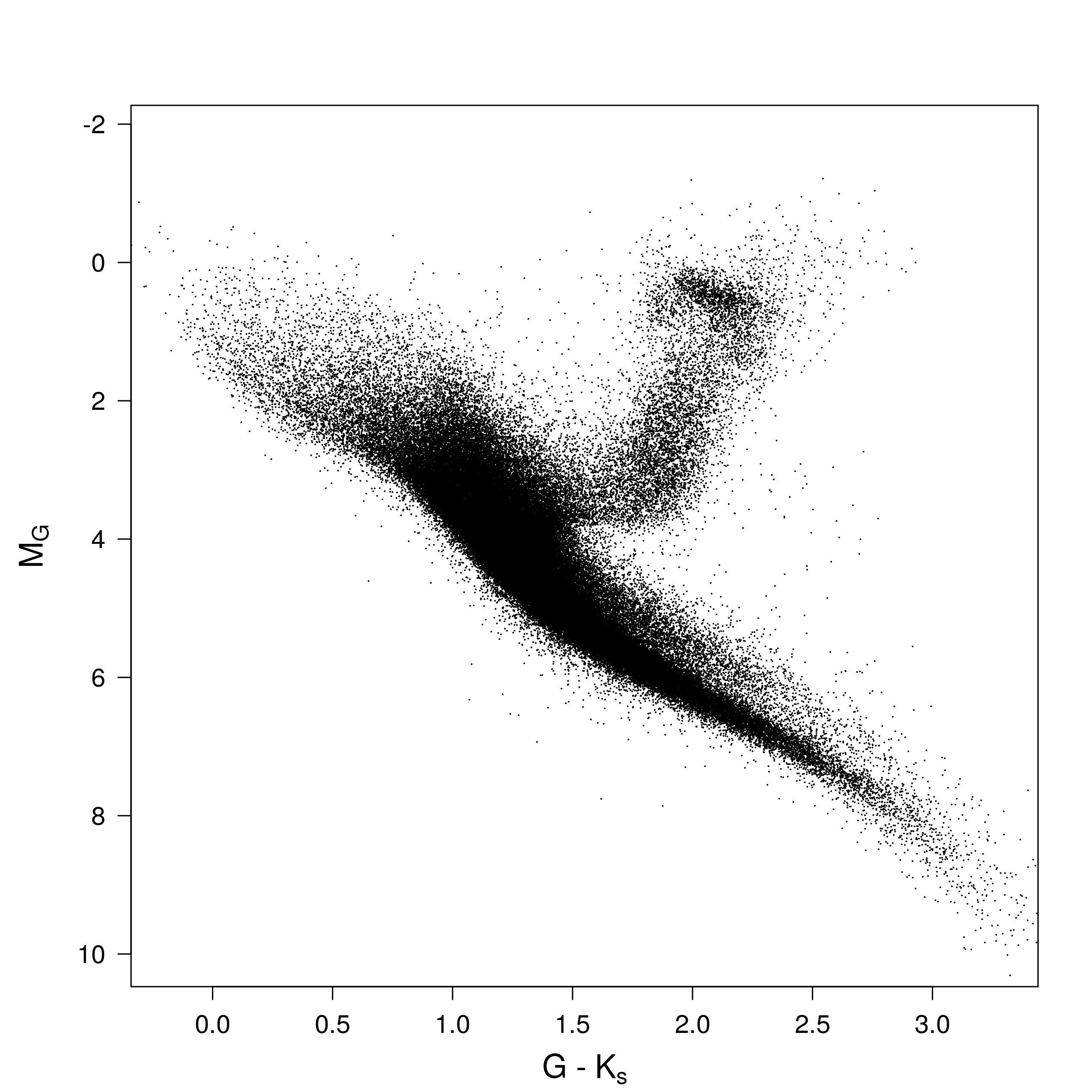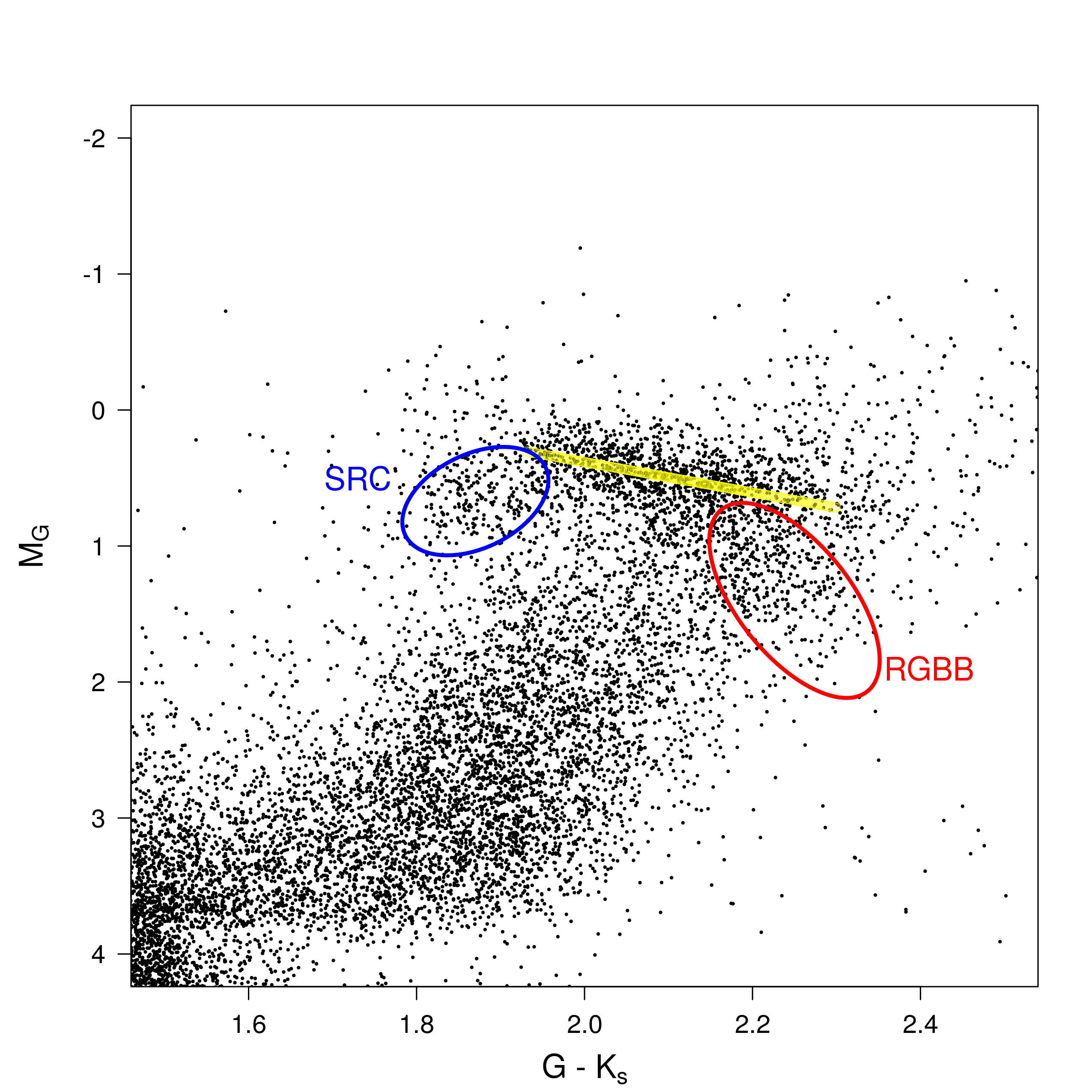IoW_20171020 - Gaia
Image of the Week |
Hertzsprung-russell Diagram Using Gaia DR1 |
 |
|
Figure 1: Hertzsprung-Russell diagram, Gaia absolute magnitude versus G-Ks colour, using Gaia DR1 with relative standard uncertainty better than 10%, 2MASS high photometric quality and low extinction stars (E(B-V)<0.015). This selection leads to 149226 stars located within 400 pc of the Sun. Note that the top of the red giant branch is absent from this diagram due to the fact that those very bright and red stars are saturated in 2MASS. |
|
Trigonometric parallaxes allow to directly estimate distances in astronomy, but their relative precision decrease with distance. To go further with high precision we need to use standard candles, like solar neighbourhood Red Clump stars whose luminosity is hardly dependent on colour, age and stellar composition. While Hipparcos giants are close enough to suffer only mildly from extinction, this is not the case anymore for the Gaia giants, even for the bright Tycho-Gaia astrometric solution (TGAS) stars of Gaia DR1. To be able to derive a Gaia Hertzsprung-Russell diagram one needs intrinsic magnitudes and colours, e.g. with a small foreground extinction or an accurate correction for this extinction. We used here the most up-to-date local 3D extinction map of Capitanio et al. (2017), built using the TGAS parallaxes, to select only low extinction stars (E(B-V)<0.015). We selected stars with relative standard uncertainties on the parallax less than 10% and good 2MASS photometry to derive the Gaia Hertzsprung-Russell diagram shown in Figure 1. This selection leads to 149 226 stars located within 400 pc of the Sun. Note that the top of the red giant branch is absent from this diagram due to the fact that those very bright and red stars are saturated in 2MASS. In the global Gaia DR1 Hertzsprung-Russell diagram presented in Brown et al. (2016), one can find a well defined lower part as here, including the binary sequence parallel to the main sequence and a few white dwarfs on the bottom left, but the upper main sequence and the red giants were spread by the extinction (the more luminous the stars the more distant and the more extincted). With a selection of low extinction stars only, the upper main sequence is narrower in colour and the red giant branch shows substructures. Figure 2 presents a zoom on the Red Clump. The Red Clump absolute magnitude, slightly dependent on the colour (temperature), produces the elongated and slightly inclined main feature (in yellow). It corresponds to cool horizontal branch stars, burning helium in their cores. On the blue side of the main Red Clump, the luminosity is fainter: it is the Secondary Red Clump (in blue). This feature is made of stars just massive enough to have ignited helium in non-degenerate conditions. |
 |
|
Figure 2: Zoom on the Red Clump region. In blue: the Secondary Red Clump. In red: the Red Giant Branch Bump. The yellow line corresponds to the obtained calibration of the Gaia absolute magnitude versus colour. |
|
Fainter than the Red Clump extending to the red side is the Red Giant Branch Bump (in red). This bump is caused by a discontinuity in hydrogen abundance which briefly interrupts the luminosity increase of the star during its ascent of the RGB, causing an excess of stars at that point. All those features are typical of a young metal-rich population. In Ruiz-Dern et al. (2017) complete and robust photometric empirical calibrations are provided for the Gaia Red Clump stars, through colour-colour, effective temperature-colour and absolute magnitude-colour relations, from the Gaia, Johnson, 2MASS, Hipparcos, Tycho-2, APASS-Sloan and WISE photometric systems, and the APOGEE DR13 spectroscopic temperatures. This was performed by using the high quality of the Gaia DR1 data. Now those calibrations are in turn being used for the validation of the Gaia DR2. Indeed, Red Clump stars may be used to check the zero point of the Gaia parallaxes and their precision if we choose them distant enough so that their estimated distance uncertainty is better than the Gaia parallax precision (Arenou et al, 2017). Within the Gaia Data Release 2 DPAC CU9 validation process this is already being applied. |
|
Credits: ESA/Gaia/DPAC, L. Ruiz-Dern, C. Babusiaux, F. Arenou, C. Turon, R. Lallement (GEPI, Observatoire de Paris) [Published: 20/10/2017] |
- Removed a total of (7) style text-align:center;
- Removed a total of (8) style text-align:justify;
- Removed a total of (1) border attribute.
- Removed a total of (1) cellpadding attribute.
- Removed a total of (1) cellspacing attribute.
Image of the Week Archive
- Removed a total of (1) border attribute.
- Removed a total of (1) cellpadding attribute.
- Removed a total of (1) cellspacing attribute.








































 Sign in
Sign in
 Science & Technology
Science & Technology